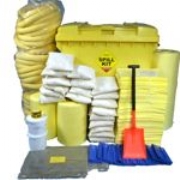 Add My Company
Add My Company
Sign In
Choosing the Right Spill Kit
06-03-2024

Which Spill Kit Do I Need?
We get a lot of enquiries about which type of spill kit is needed, or whether or not a kit is actually required. Some customers feel that because they might only have a couple of 10 gallon drums of 'something' they don't even need absorbents let alone a spill kit.
The problem is when that a container of 'something' gets knocked over, starts leaking or is punctured, what are you going to do?
Now that you've got to this page it's assumed that you 'think' you might need a spill kit. Let's face it, if you read beyond here then you probably do.
So you are really interested in finding out which type of spill kit you need. The usual starting point is by first making a list of the liquids used or stored at your location. If you are not sure this is not a major problem, maybe you are in the storage or courier business for example, and different containers of fluid come in and out every day, there is a kit for this type of situation.
Assuming that you know what types of liquids are used at your location. If you had a spill, where would it be? Could it be on land or could it be on water - or could it be both? It could be quite a costly mistake not to have the proper spill kits on hand. There are the three basic types of spill kits in the absorbents industry.
* The General Purpose or Universal Spill Kit ? These are for land spills only. They will absorb all water based liquids and oils but are not recommended for corrosive liquids.
* The Oil Only or Oil and Fuel Spill Kit - These can be used for land or water spills. They should only be used with oil, fuel or any hydrocarbon based fluid as they will repel water. The great thing about these absorbents is that they will float on water and still absorb the oil or fuel. They are not recommended for use with corrosive liquids.
* The Chemical or Hazmat Spill Kit ? These are for land use only. They will absorb almost any water based liquids and oils, acids and bases and can be used with corrosive liquids.
If you are not sure what type of fluid or chemical you might need to absorb but you are using it on 'land', then the safest option would be to opt for the Chemical Spill Kit. This is based on the fact that Chemical Absorbents will soak up pretty much anything so you won't need to worry about what it was that was spilt.
So now that you have decided on which type of kit you need you should then look at the size. To find this out you need to ask -
* What is the largest amount of liquid that could be spilled at this location?
* What is your worst case scenario?
Determining the size of kit is a tricky business and we can only give some general guidance here, because there could be many other factors that should be taken into account, things like are there any drains in the area of the potential spill. If the total volume of liquid that could be spilled is several thousand litres or more, you might need to look at other 'built' methods of retaining the liquids.
But let's say you keep, or handle, a smaller quantity of drums of liquid ranging from 25 to 200 litres, they are stored in a dry area that is used for dispensing and they are a mixture of oil based and light acids. Assuming that you have nothing at all in the way of absorbents, you might want to look at drip trays with Chemical pads to catch the drips from taps and a 250 Litre mobile Chemical Kit that can be kept near the drums but could be also moved to another location in an emergency. The Chemical Spill Kit would be a good choice because it would cover all the types of fluids you store and you're working in a rain-proof environment. You might also want to consider having several smaller 20 Litre kits that could be mounted to walls in areas where the fluids are used.
The main thing is that if a spill happens you need to have at your disposal the means to control it. It is not always practical to have en
For more information on Choosing the Right Spill Kit talk to SERPRO Ltd
Enquire Now
List your company on FindTheNeedle.

